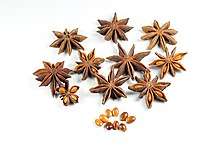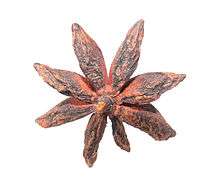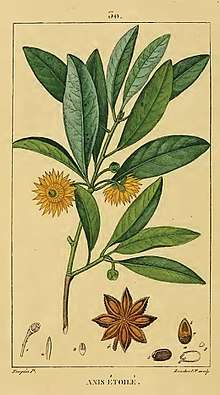Illicium verum
Illicium verum is a medium-sized evergreen tree native to northeast Vietnam and southwest China. A spice commonly called star anise, staranise, star anise seed, Chinese star anise, or badian that closely resembles anise in flavor is obtained from the star-shaped pericarps of the fruit of I. verum which are harvested just before ripening. Star anise oil is a highly fragrant oil used in cooking, perfumery, soaps, toothpastes, mouthwashes, and skin creams. About 90% of the world's star anise crop is used for extraction of shikimic acid, a chemical intermediate used in the synthesis of oseltamivir (Tamiflu).
| Illicium verum | |
|---|---|
 | |
| Star anise fruits and seeds | |
| Scientific classification | |
| Kingdom: | Plantae |
| Clade: | Tracheophytes |
| Clade: | Angiosperms |
| Order: | Austrobaileyales |
| Family: | Schisandraceae |
| Genus: | Illicium |
| Species: | I. verum |
| Binomial name | |
| Illicium verum | |
| Synonyms[1] | |
| |
Nomenclature
| Star anise | |||||||||||||||||||
|---|---|---|---|---|---|---|---|---|---|---|---|---|---|---|---|---|---|---|---|
| Chinese | 八角 | ||||||||||||||||||
| Literal meaning | "eight-horns" | ||||||||||||||||||
| |||||||||||||||||||
Illicium comes from the Latin illicio meaning "entice".
The name "badian" appears to derive, via French badiane, from the apparently descriptive Chinese name for it, 八角, pinyin: bājiǎo, lit. "eight horns". However, a derivation from the Persian بادیان bādiyān, "fennel", exists, with the Oxford English Dictionary indicating that its origin before that is unknown.[2]
Use
Culinary use


Star anise contains anethole, the same compound that gives the unrelated anise its flavor. Recently, star anise has come into use in the West as a less expensive substitute for anise in baking, as well as in liquor production, most distinctively in the production of the liqueur Galliano.[3] Star anise enhances the flavour of meat.[4]
It is used as a spice in preparation of biryani and masala chai all over the Indian subcontinent. It is widely used in Chinese cuisine, and in Malay and Indonesian cuisines. It is widely grown for commercial use in China, India, and most other countries in Asia. Star anise is an ingredient of the traditional five-spice powder of Chinese cooking. It is also a major ingredient in the making of phở, a Vietnamese noodle soup.
It is also used in the French recipe of mulled wine, called vin chaud (hot wine). If allowed to steep in coffee, it deepens and enriches the flavor. The pods can be used in this manner multiple times by the pot-full or cup, as the ease of extraction of the taste components increases with the permeation of hot water.
Drug precursor
Star anise is the major source of the chemical compound shikimic acid, a primary precursor in the pharmaceutical synthesis of the antiinfluenza drug oseltamivir (Tamiflu).[5][6][7] An industrial method for the production of shikimic acid using fermentation of E. coli bacteria was discovered in 2005,[8][9] and applied in the 2009 swine flu pandemic to address Tamiflu shortages, also causing price increases for star anise as a raw material of shikimic acid.[10] As of 2018, fermentation of E. coli was the manufacturing process of choice to produce shikimic acid for synthesis of Tamiflu.[5][6] Study shows Star Anise can be used as anti quorum sensing and anti-biofilm agent in food matrix.[11]
Toxicity
Japanese star anise (Illicium anisatum), a similar tree, is highly toxic and inedible; in Japan, it has instead been burned as incense. Cases of illness, including "serious neurological effects, such as seizures", reported after using star anise tea, may be a result of deliberate economically motivated adulteration with this species. Japanese star anise contains the neurotoxin anisatin,[12] which also causes severe inflammation of the kidneys (nephritis), urinary tract, and digestive organs when ingested.[13]
Swamp star anise Illicium parviflorum is a similar tree found in the Southern United States, and due to its toxicity, it should not be used for folk remedies or as a cooking ingredient.[14]
Standardization of its products and services
- ISO 676:1995 - contains the information about the nomenclature of the variety and cultivars[15]
Identification
- Refer to the 4th edition of the European Pharmacopoeia (1153)
Differentiation from other species
Joshi et al. have used fluorescent microscopy and gas chromatography[16] to distinguish the species, while Lederer et al. employed thin layer chromatography with HPLC-MS/MS.[17]
Specifications
- ISO 11178:1995 - a specification for its dried fruits[18]
References
- "The Plant List: A Working List of All Plant Species". Retrieved 3 September 2015.
- "badian, n.". OED Online. September 2019. Oxford University Press. https://www-oed-com.library.access.arlingtonva.us/view/Entry/14568?redirectedFrom=badiane (accessed September 08, 2019).
- "Galliano". Retrieved 13 March 2016.
- "Spaghetti Bolognese". In Search of Perfection. BBC Two.
- Bilal, Muhammad; Wang, Songwei; Iqbal, Hafiz M. N.; Zhao, Yuping; Hu, Hongbo; Wang, Wei; Zhang, Xuehong (16 July 2018). "Metabolic engineering strategies for enhanced shikimate biosynthesis: current scenario and future developments". Applied Microbiology and Biotechnology. 102 (18): 7759–7773. doi:10.1007/s00253-018-9222-z. ISSN 0175-7598. PMID 30014168.
- "Oseltamivir (Tamiflu): Uses, Dosage, Side Effects". Drugs.com. 8 May 2018. Retrieved 31 January 2019.
- Wang, G. W.; Hu, W. T.; Huang, B. K.; Qin, L. P. (2011). "Illicium verum: A review on its botany, traditional use, chemistry and pharmacology". Journal of Ethnopharmacology. 136 (1): 10–20. doi:10.1016/j.jep.2011.04.051. PMID 21549817.
- Bradley, D. (December 2005). "Star role for bacteria in controlling flu pandemic?". Nature Reviews Drug Discovery. 4 (12): 945–946. doi:10.1038/nrd1917. ISSN 1474-1776. PMID 16370070.
- Krämer, M.; Bongaerts, J.; Bovenberg, R.; Kremer, S.; Müller, U.; Orf, S.; Wubbolts, M.; Raeven, L. (2003). "Metabolic engineering for microbial production of shikimic acid". Metabolic Engineering. 5 (4): 277–283. doi:10.1016/j.ymben.2003.09.001. PMID 14642355.
- Louisa Lim (18 May 2009). "Swine flu bumps up price of Chinese spice". US National Public Radio.
- MD Ramim Tanver Rahman, Zaixiang Lou, Jun Zhang, Fuhao Yu, Yakindra Prasad Timilsena, Caili Zhang, Yi Zhang, and Amr M. Bakry (2017) Star Anise (Illicium verum Hook. f.) as Quorum Sensing and Biofilm Formation Inhibitor on Foodborne Bacteria: Study in Milk. Journal of Food Protection: April 2017, Vol. 80, No. 4, pp. 645-653. https://doi.org/10.4315/0362-028X.JFP-16-294
- "Anisatin". PubChem, National Library of Medicine, US National Institutes of Health. 11 May 2019. Retrieved 17 May 2019.
- Perret, C.; Tabin, R.; Marcoz, J.-P.; Llor, J.; Cheseaux, J.-J. (2011). "Malaise du nourrisson pensez à une intoxication à l'anis étoilé" [Apparent life-threatening event in infants: think about star anise intoxication]. Archives de Pédiatrie. 18 (7): 750–753. doi:10.1016/j.arcped.2011.03.024. PMID 21652187.
- "How to grow star anise". 28 October 2015.
- International Organization for Standardization. "ISO 676:1995 Spices and condiments -- Botanical nomenclature". Retrieved 8 June 2009.
- Joshi, Vaishali C.; Ragone, S; Bruck, IS; Bernstein, JN; Duchowny, M; Peña, BM (2005). "Rapid and easy identification of Illicium verum Hook. f. and its adulterant Illicium anisatum Linn. by fluorescent microscopy and gas chromatography". Journal of AOAC International. 88 (3): 703–706. PMID 16001842. Retrieved 10 November 2007.
- Lederer, Ines; Schulzki, G; Gross, J; Steffen, JP (2006). "Combination of TLC and HPLC-MS/MS methods. Approach to a rational quality control of Chinese star anise". Journal of Agricultural and Food Chemistry. 54 (6): 1970–1974. doi:10.1021/jf058156b. PMID 16536563.
- International Organization for Standardization. "ISO 11178:1995 Star anise (Illicium verum Hook. f.) -- Specification". Retrieved 8 June 2009.
| Wikimedia Commons has media related to Illicium verum. |